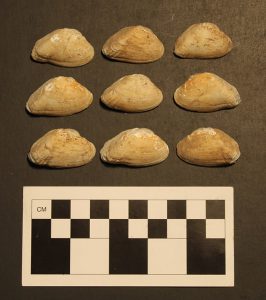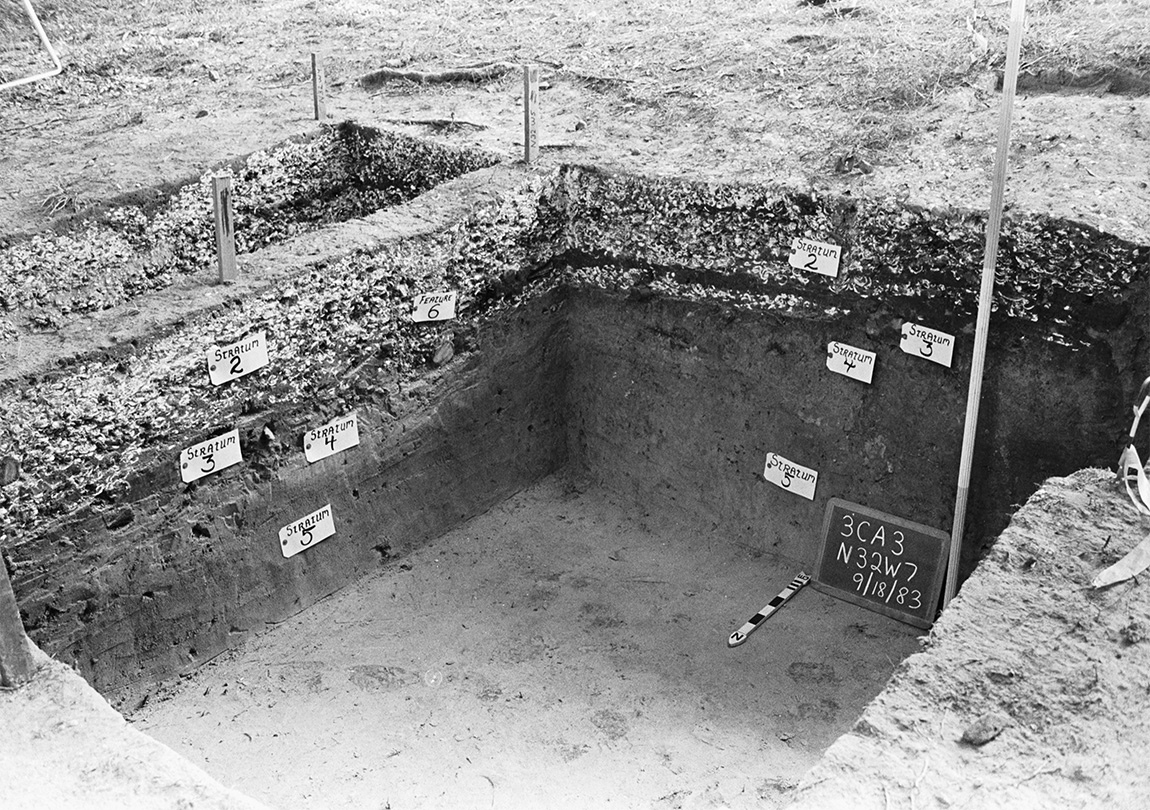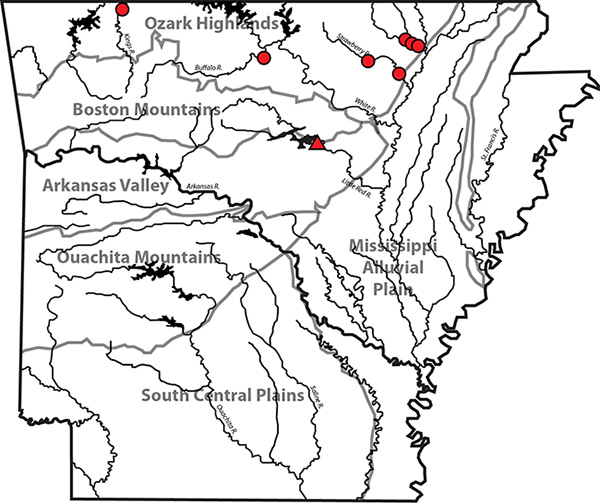Robert J. Scott, ARAS-UAPB Research Station
Artifact of the Month - May 2020

We are changing things up for the month of May. Instead of an artifact we are highlighting ecofacts (biological remains such as bone, shell, and charred plant remains found in archeological contexts). Specifically, shells of a species of freshwater mussel, Epioblasma triquetra (snuffbox) (Figure 1), from the prehistoric Heber Springs site (3CE68) located on the Little Red River in Cleburne County, Arkansas.
The Heber Springs site was excavated by the Arkansas Archeological Survey in 1979 to investigate a conspicuous, but little understood, category of sites found in the floodplains of most major Ozark streams. These sites consist of dense accumulations of food remains, artifacts, and dark soil. A distinctive characteristic of many of these sites is their extensive shell middens—layers of moderately to densely packed shell (Figure 2, see below). The excavations encountered rich midden deposits and mussel shell accumulations that extended to a depth of just over one meter. The site yielded a significant quantity of artifacts, animal bone, and plant remains, as well as over 60 kg of shell. Artifacts from test units included grog- and shell-tempered pottery, arrow points, and pitted cobbles. Among the shell-tempered ceramics were sherds of flat-bottomed vessels characteristic of the Early Mississippi period (AD 700–1000).

Unstudied since 1979, the mussel shell recovered from Heber Springs was recently analyzed to address some research questions: What season(s) of the year was the site occupied? What was the dietary contribution of freshwater mussels? Did local ecological conditions change significantly during prehistory? We also wanted to find out if taxonomic analysis of archeological shell (i.e., identifying the genus and species of each mussel shell found at the site) is justified from an applied or resource management standpoint.
Freshwater mussels (Bivalvia: Unionidae) are one of the most endangered groups of organisms in the world today. An important component of conservation efforts is to identify the original ranges of mussels and how they have changed over time. Studies of prehistoric mussel assemblages contribute to this effort by providing data on the geographic distribution and relative abundance of mussel taxa in streams prior to modern (Historic period) human environmental impacts (channelization, impoundment, agricultural run-off, chemical pollution, and so on). A number of applied zooarcheological studies of prehistoric mussels have resulted in new stream records of species, which in some cases led to major range extensions of mussel taxa (e.g., Gordon 1983; Mitchell and Peacock 2014; Peacock et al. 2013; Peacock et al. 2017). For example, Cyprogenia aberti (western fanshell), once thought to have been endemic to rivers in the Interior Highlands (Ozarks and Ouachita Mountains), has been identified at archeological sites located along eastern tributaries of the Mississippi River (Peacock and Jenkins 2002). In northwest Arkansas, a new stream record, Alasmidonta viridis (slippershell), was identified for the Buffalo National River from mussel shell recovered at looted rock shelter sites (Clark et al. 2008).

The freshwater mussel shell assemblage from Heber Springs consisted of 13,602 individual valves, of which 10,290 were identifiable to genus and species. A minimum of 29 different species are represented in the collection. The assemblage is dominated by 7 species. In declining order of abundance, the most common are Eurynia dilatata (spike), Fusconaia flava (Wabash pigtoe), Cyprogenia aberti (western fanshell), Cyclonaias tuberculata (purple wartyback), Pleurobema sintoxia (round pigtoe), Actinonaias ligamentina (mucket), and Ptychobrancus occidentalus (Ouachita kidneyshell). The remaining “minority” taxa each make up less than 1% of the identifiable mussel shell. Comparison with modern data on mussels of the Little Red River drainage revealed that one of the minority species, Epioblasma triquetra (snuffbox), has not been documented in the stream historically (Fowler and Anderson 2015:980–981).
Epioblasma triquetra is one of the rarest species of freshwater mussel found in the state of Arkansas today (Harris and Gordon 1990; Harris et al. 2009:69). Consequently, the most recent review of the conservation status of freshwater mussels in Arkansas ranked the species as critically imperiled—at highest risk of extinction due to extreme rarity or steep population declines (Fowler and Anderson 2015). Modern surveys have recorded the presence of Epioblasma triquetra in the Kings, Buffalo, Spring, and Strawberry rivers (Figure 3) at locations in the Ozark Highlands (Fowler and Anderson 2015:980–981). The occurrence of this species at the Heber Springs site is significant because it demonstrates its distribution was more widespread than previously thought. Additional mussel surveys of the Little Red River drainage are ultimately needed to determine if Epioblasma triquetra has truly been extirpated from the river, or is still present but extremely rare.
References
Clark, C. F., Faron D. Usrey, and Shawn Hodges
2008 Salvaged Mussels: Reconstructing Prehistoric conditions from looted archaeological sites at Buffalo National River. Park Science 25(1):30–31.
Fowler, Allison, and Jane Anderson
2015 Arkansas Wildlife Action Plain. Arkansas Game and Fish Commission, Little Rock.
Gordon, Mark E.
1983 A Pre-European Occurrence of Glebula rotundata (Bivalvia: Unionidae) in Arkansas. The Nautilus 97:42.
Harris, John L., and Mark E. Gordon
1990 Arkansas Mussels. Arkansas Game and Fish Commission, Little Rock, AR.
Harris, J. L., W. R. Posey II, C. L. Davidson, J. L. Farris, S. R. Oetker, J. N. Stoeckel, B. G. Crump, M. S. Barnett, H. C. Martin, M. W. Mathews, J. H. Seagraves, N. J. Wentz, R. Winterringer, C. Osborne, and A. D. Christian
2009 Unionoida (Mollusca:Margaritiferidae, Unionidae) in Arkansas, Third Status Review. Journal of the Arkansas Academy of Science 63:50–86.
Mitchell, Joseph, and Evan Peacock
2014 A Prehistoric Freshwater Mussel Assemblage from the Big Sunflower River, Sunflower County, Mississippi. Southeastern Naturalist 13(3):626–638.
Peacock, Evan, and Thomas R. James
2002 A Prehistoric Unionid Assemblage from the Big Black River Drainage in Hinds County, Mississippi. Journal of the Mississippi Academy of Science 47:119–123.
Peacock, Evan, and C. Jenkins
2010 The Distribution and Research Value of Archaeological Mussel Shell: An Overview from Mississippi. Midcontinental Journal of Archaeology 35:91–116.
Peacock, Evan, Cliff Jenkins, Paul F. Jacobs, and Joseph Greenleaf
2011 Archaeology and Biogeography of Prehistoric Freshwater Mussel Shell in Mississippi. British Archaeological Reports, International Series 2297. Hadrian Books, Oxford, UK.
Peacock, Evan, Amy Moe-Hoffman, Robert Scott, and Marvin D. Jeter
2013 Prehistoric Freshwater Mussel Faunas from Bayou Bartholomew, Southeast Arkansas. Southeastern Archaeology 32:1–13.
Peacock, Evan, Joseph Mitchell, and C. Andrew Buchner
2017 Applied Zooarchaeology of Freshwater Mussel (Bivalvia: Unionidae) Shell from Golson (22HU508), A Deasonville-Period Site on the Yazoo River, Mississippi. Environmental Archaeology http://dx.doi.org/10.1080/14614103.2017.1279841.
 Collections and items in our institution have incomplete, inaccurate, and/or missing attribution. We are using this notice to clearly identify this material so that it can be updated, or corrected by communities of origin. Our institution is committed to collaboration and partnerships to address this problem of incorrect or missing attribution. For more information, visit localcontexts.org.
Collections and items in our institution have incomplete, inaccurate, and/or missing attribution. We are using this notice to clearly identify this material so that it can be updated, or corrected by communities of origin. Our institution is committed to collaboration and partnerships to address this problem of incorrect or missing attribution. For more information, visit localcontexts.org.
 The Arkansas Archeological Survey is committed to the development of new modes of collaboration, engagement, and partnership with Indigenous peoples for the care and stewardship of past and future heritage collections.
The Arkansas Archeological Survey is committed to the development of new modes of collaboration, engagement, and partnership with Indigenous peoples for the care and stewardship of past and future heritage collections.
 The TK Notice is a visible notification that there are accompanying cultural rights and responsibilities that need further attention for any future sharing and use of this material. The TK Notice may indicate that TK Labels are in development and their implementation is being negotiated. For more information about the TK Notice, visit localcontexts.org.
The TK Notice is a visible notification that there are accompanying cultural rights and responsibilities that need further attention for any future sharing and use of this material. The TK Notice may indicate that TK Labels are in development and their implementation is being negotiated. For more information about the TK Notice, visit localcontexts.org.
